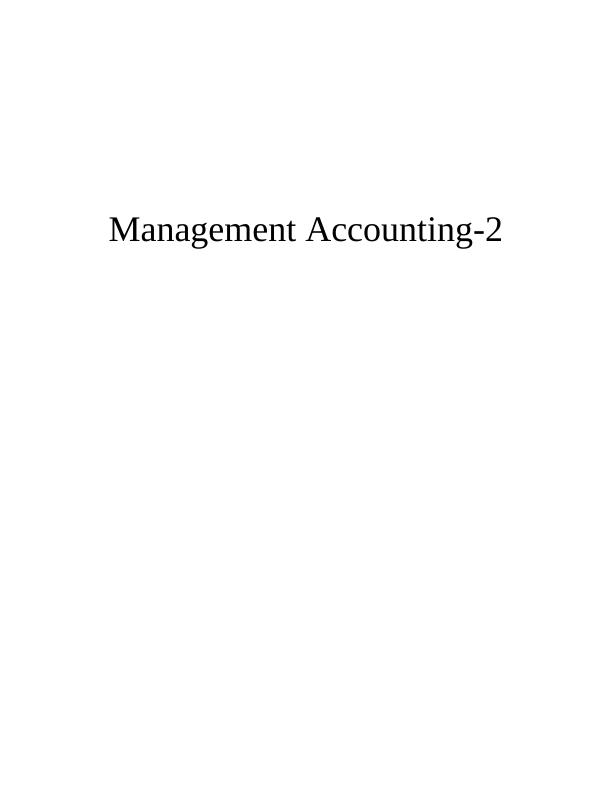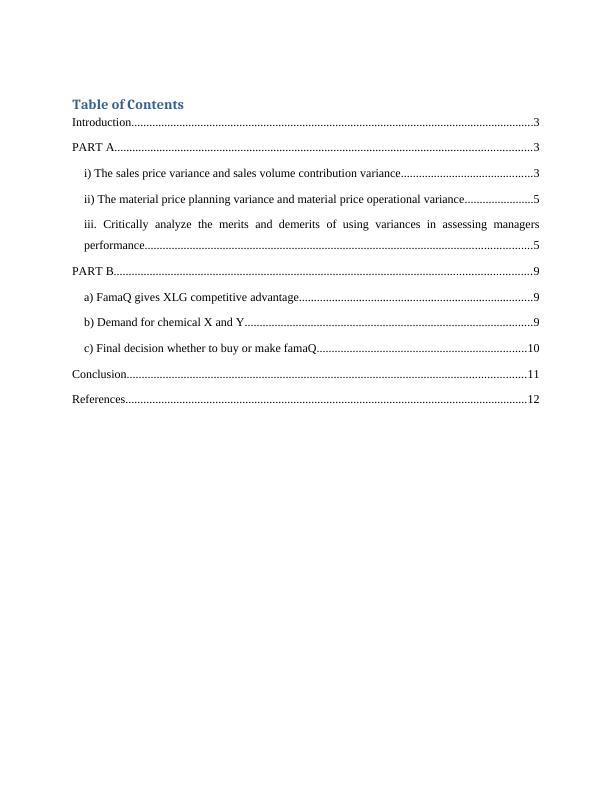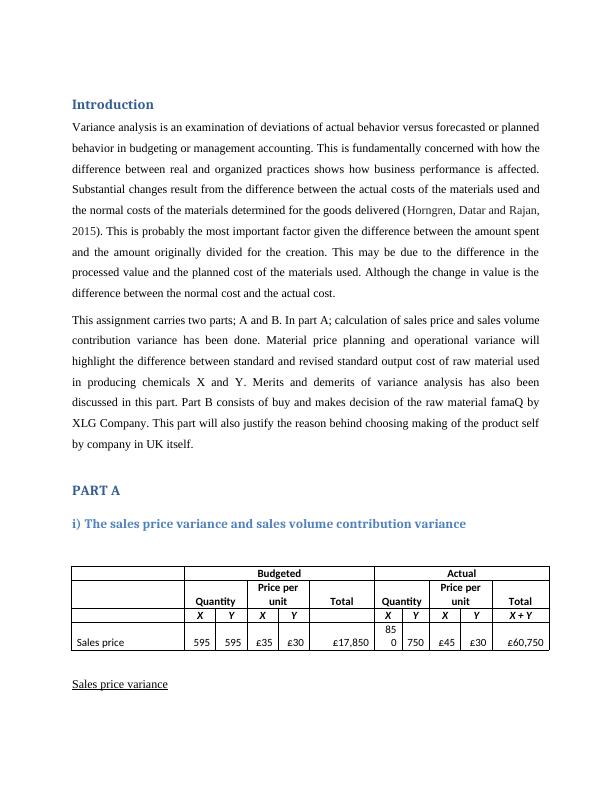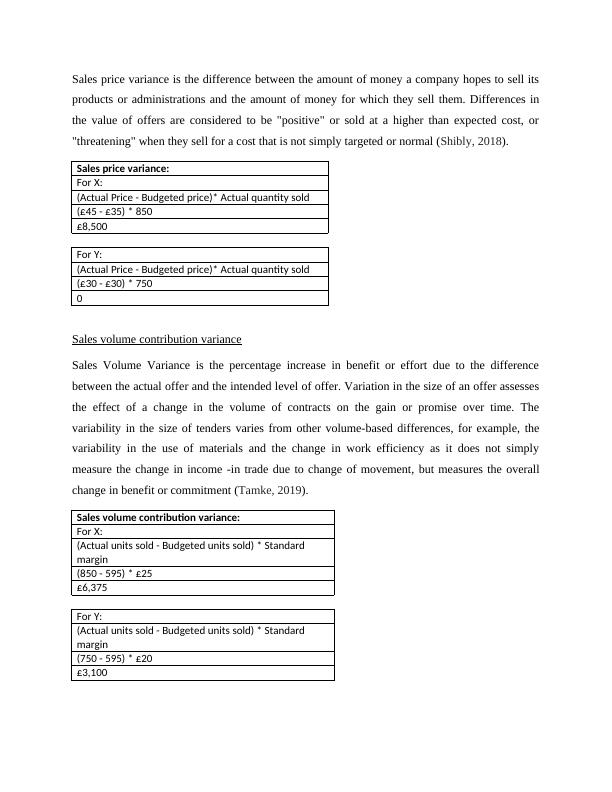Variance Analysis in Management Accounting
Added on 2023-01-07
12 Pages3140 Words31 Views
Management Accounting-2

Table of Contents
Introduction......................................................................................................................................3
PART A...........................................................................................................................................3
i) The sales price variance and sales volume contribution variance............................................3
ii) The material price planning variance and material price operational variance.......................5
iii. Critically analyze the merits and demerits of using variances in assessing managers
performance.................................................................................................................................5
PART B...........................................................................................................................................9
a) FamaQ gives XLG competitive advantage..............................................................................9
b) Demand for chemical X and Y................................................................................................9
c) Final decision whether to buy or make famaQ......................................................................10
Conclusion.....................................................................................................................................11
References......................................................................................................................................12
Introduction......................................................................................................................................3
PART A...........................................................................................................................................3
i) The sales price variance and sales volume contribution variance............................................3
ii) The material price planning variance and material price operational variance.......................5
iii. Critically analyze the merits and demerits of using variances in assessing managers
performance.................................................................................................................................5
PART B...........................................................................................................................................9
a) FamaQ gives XLG competitive advantage..............................................................................9
b) Demand for chemical X and Y................................................................................................9
c) Final decision whether to buy or make famaQ......................................................................10
Conclusion.....................................................................................................................................11
References......................................................................................................................................12

Introduction
Variance analysis is an examination of deviations of actual behavior versus forecasted or planned
behavior in budgeting or management accounting. This is fundamentally concerned with how the
difference between real and organized practices shows how business performance is affected.
Substantial changes result from the difference between the actual costs of the materials used and
the normal costs of the materials determined for the goods delivered (Horngren, Datar and Rajan,
2015). This is probably the most important factor given the difference between the amount spent
and the amount originally divided for the creation. This may be due to the difference in the
processed value and the planned cost of the materials used. Although the change in value is the
difference between the normal cost and the actual cost.
This assignment carries two parts; A and B. In part A; calculation of sales price and sales volume
contribution variance has been done. Material price planning and operational variance will
highlight the difference between standard and revised standard output cost of raw material used
in producing chemicals X and Y. Merits and demerits of variance analysis has also been
discussed in this part. Part B consists of buy and makes decision of the raw material famaQ by
XLG Company. This part will also justify the reason behind choosing making of the product self
by company in UK itself.
PART A
i) The sales price variance and sales volume contribution variance
Budgeted Actual
Quantity
Price per
unit Total Quantity
Price per
unit Total
X Y X Y X Y X Y X + Y
Sales price 595 595 £35 £30 £17,850
85
0 750 £45 £30 £60,750
Sales price variance
Variance analysis is an examination of deviations of actual behavior versus forecasted or planned
behavior in budgeting or management accounting. This is fundamentally concerned with how the
difference between real and organized practices shows how business performance is affected.
Substantial changes result from the difference between the actual costs of the materials used and
the normal costs of the materials determined for the goods delivered (Horngren, Datar and Rajan,
2015). This is probably the most important factor given the difference between the amount spent
and the amount originally divided for the creation. This may be due to the difference in the
processed value and the planned cost of the materials used. Although the change in value is the
difference between the normal cost and the actual cost.
This assignment carries two parts; A and B. In part A; calculation of sales price and sales volume
contribution variance has been done. Material price planning and operational variance will
highlight the difference between standard and revised standard output cost of raw material used
in producing chemicals X and Y. Merits and demerits of variance analysis has also been
discussed in this part. Part B consists of buy and makes decision of the raw material famaQ by
XLG Company. This part will also justify the reason behind choosing making of the product self
by company in UK itself.
PART A
i) The sales price variance and sales volume contribution variance
Budgeted Actual
Quantity
Price per
unit Total Quantity
Price per
unit Total
X Y X Y X Y X Y X + Y
Sales price 595 595 £35 £30 £17,850
85
0 750 £45 £30 £60,750
Sales price variance

Sales price variance is the difference between the amount of money a company hopes to sell its
products or administrations and the amount of money for which they sell them. Differences in
the value of offers are considered to be "positive" or sold at a higher than expected cost, or
"threatening" when they sell for a cost that is not simply targeted or normal (Shibly, 2018).
Sales price variance:
For X:
(Actual Price - Budgeted price)* Actual quantity sold
(£45 - £35) * 850
£8,500
For Y:
(Actual Price - Budgeted price)* Actual quantity sold
(£30 - £30) * 750
0
Sales volume contribution variance
Sales Volume Variance is the percentage increase in benefit or effort due to the difference
between the actual offer and the intended level of offer. Variation in the size of an offer assesses
the effect of a change in the volume of contracts on the gain or promise over time. The
variability in the size of tenders varies from other volume-based differences, for example, the
variability in the use of materials and the change in work efficiency as it does not simply
measure the change in income -in trade due to change of movement, but measures the overall
change in benefit or commitment (Tamke, 2019).
Sales volume contribution variance:
For X:
(Actual units sold - Budgeted units sold) * Standard
margin
(850 - 595) * £25
£6,375
For Y:
(Actual units sold - Budgeted units sold) * Standard
margin
(750 - 595) * £20
£3,100
products or administrations and the amount of money for which they sell them. Differences in
the value of offers are considered to be "positive" or sold at a higher than expected cost, or
"threatening" when they sell for a cost that is not simply targeted or normal (Shibly, 2018).
Sales price variance:
For X:
(Actual Price - Budgeted price)* Actual quantity sold
(£45 - £35) * 850
£8,500
For Y:
(Actual Price - Budgeted price)* Actual quantity sold
(£30 - £30) * 750
0
Sales volume contribution variance
Sales Volume Variance is the percentage increase in benefit or effort due to the difference
between the actual offer and the intended level of offer. Variation in the size of an offer assesses
the effect of a change in the volume of contracts on the gain or promise over time. The
variability in the size of tenders varies from other volume-based differences, for example, the
variability in the use of materials and the change in work efficiency as it does not simply
measure the change in income -in trade due to change of movement, but measures the overall
change in benefit or commitment (Tamke, 2019).
Sales volume contribution variance:
For X:
(Actual units sold - Budgeted units sold) * Standard
margin
(850 - 595) * £25
£6,375
For Y:
(Actual units sold - Budgeted units sold) * Standard
margin
(750 - 595) * £20
£3,100

End of preview
Want to access all the pages? Upload your documents or become a member.
Related Documents
Management Accounting: Sales Variance, Material Variance, and Performance Evaluationlg...
|14
|3460
|98
MANAGEMENT ACCOUNTING - REPORTlg...
|12
|3134
|71
Variance in Assessing Performance and Decision Makinglg...
|15
|3344
|66
Management Accounting: Sales Price Variance, Material Price Variance, and Performance Evaluationlg...
|15
|3285
|47
Variance Analysis for Assessing Manager Performance in Management Accountinglg...
|11
|3061
|98
Variance Analysis in Management Accountinglg...
|12
|3302
|69
